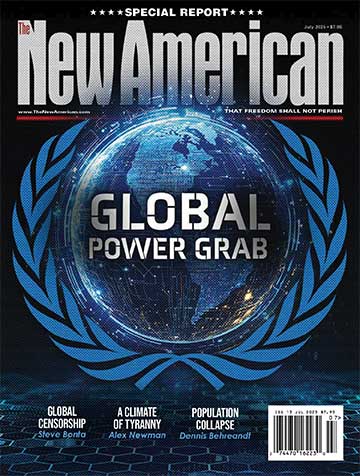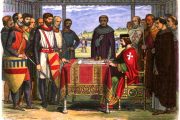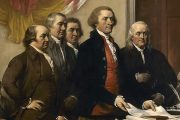President Obama’s announcement yesterday that he is taking steps to end our “outdated approach” with Cuba and re-establish diplomatic relations has kicked up a firestorm of controversy. But one element that may be widely overlooked in the debate is how influential forces in the U.S. government and major media significantly aided and abetted Castro in his bid for communist domination of the island. This history, from Castro’s guerrilla activities against the Batista regime to the Bay of Pigs fiasco, is examined below. A basic understanding of this history is important, since if Castro was unable to subject the Cuban people to totalitarian rule to begin with, there would have been no flood of Cuban refugees fleeing communist tyranny, no embargo, and no breaking of U.S.-Cuba diplomatic relations — and therefore no present-day discussion about ending our “outdated approach” with Cuba. — The editors
Castro’s Communist Credentials
By the time Castro landed in Cuba’s Oriente Province in 1956 with a tiny band of revolutionaries, he had already manifested a strong link to communism dating back to the 1948 uprisings in Bogota, Colombia. In Colombia, the 22-year-old Havana University law-school student actively helped organize the insurrection. The “Bogotazo,” as it was known, which involved looting, murder, and the takeover by communists of radio stations and government buildings, revealed Castro’s communist affiliation and should have made Castro a pariah on the American political scene. But elements within the U.S. State Department and CIA refused to acknowledge the fact, setting the stage for his eventual triumph in Cuba.
In close cooperation with New York Times reporter Herbert Matthews, the State Department kept up Castro’s noncommunist appearance. It was a deception that worked amazingly well in the halls of Congress and on the American street.
After an interview with Castro, Matthews described the bearded revolutionary as a “man of ideals” who “has strong ideas of liberty, democracy, social justice, the need to restore the Constitution, to hold elections.” Matthews even went as far as to describe Castro as an “anti-communist.” At the same time, the New York Times painted Batista with broad strokes as a right-wing dictator ready to suspend constitutional guarantees at the drop of a hat. The State Department even required the newly appointed U.S. ambassador to Cuba, Earl E.T. Smith, to be briefed by Matthews in 1957.
After spending some time in Cuba, Smith conducted an intensive background check of Fidel Castro. He questioned anti-Batista elements that included members of the clergy, intellectuals, and professional men. These individuals, though not supporters of Batista, were unanimous in their assessment that Castro was a terroristic communist whose ascendance to power would not be in the best interest of the Cuban people. The idea that the anti-Batista element was unanimously pro-Castro was a lie. Aware of Castro’s communist affiliation, Smith attempted to engage the CIA in an effort to monitor Communist Party strength in Cuba. Although the communists had polled over 120,000 votes the last time they voted as a party, the CIA insisted that card-carrying communists numbered merely 10,000, and that sympathizers numbered no more than 20,000. Several months after assuming his post as chief of mission in Havana, Smith recommended to CIA Director Allen Dulles that a CIA operative infiltrate Castro’s top echelon to monitor the extent of communist infiltration. Smith assumed that this was never done, given the CIA’s seemingly complete lack of knowledge regarding communist infiltration among Castro’s movement.
In 1960, U.S. Secretary of State Christian Herter was still trumpeting the company line when he remarked: “I don’t think anyone could say affirmatively that Cuba is Communist at the present time. “Despite Smith’s warnings about Castro’s communist alignment, the State Department and the establishment media successfully maintained the illusion that Castro was clean. With the influential New York Times firmly in his pocket shaping American policy and opinion, Castro did not need to achieve military victory. He simply had to wait until a demoralized Cuban government gave up.
How was it possible that the State Department and the CIA could smother the fact that Castro was a communist? Through some clever maneuvering by William Wieland and Roy Rubottom, both of whom were on the staff of the U.S. Embassy in Bogota, the true political nature of Castro was suppressed by key elements in each department. Although they knew otherwise, Wieland and Rubottom continued to maintain that Fidel was not a communist, even as late as 1961 when it had become apparent to even the most idealistic that Castro was not the freedom-loving hero portrayed by the media.
Interventionist “Nonintervention”
Meanwhile, through the concerted efforts of the U.S. State Department and Herbert Matthews of the New York Times, Batista’s government was undermined both politically and publicly. While State Department policy regarding nonintervention prevented Ambassador Smith from providing support to the Batista government, the State Department looked the other way while pro-Castro groups operated freely in Miami. These pro-Castro groups worked actively to secure supplies, money, and weaponry for Castro’s ragtag revolutionaries. Meanwhile Batista came up empty when the United States, historically Cuba’s closest ally, refused to ship armored cars purchased by the Cuban government. This action emboldened Castro’s forces and demoralized the national government. It can be said that the United States effectively intervened on the side of Castro by working to bring about the fall of Batista.
Castro’s terrorist activities continued and included the abduction of 47 Americans, who were freed after a week of captivity. In March 1958, U.S. Secretary of State John Foster Dulles dealt a death blow to the Batista government by refusing to ship 1,950 Garand rifles legally purchased by the Cuban government. It was a mortal blow from which Batista failed to recover. Dulles claimed that he took this action in the interest of “nonintervention,” but here again the United States was essentially providing aid to Castro’s forces by subverting the efforts of the national government.
Still all was not lost. A Cuban anti-communist candidate for president, and former prime minister, Dr. Andres Rivero Aguero, was elected in November 1958 (after Batista was prohibited from running for reelection), but he too, like Batista, was ultimately undermined by the U.S. State Department under the same pretense of “nonintervention.” Aguero handily defeated his opponent, former president Ramon Grau St. Martin, but Aguero faced the same pressures that Batista faced: Castro’s growing confidence that the United States would not intervene on behalf of the national government, and the reluctance of the State Department to reveal the true nature of the situation, coupled with the United States’ intrusive “nonintervention” policy that promised to hinder the national government. This reality painted a bleak picture for the survival of the national government. With Castro’s takeover imminent, Aguero was forced to leave the island in January 1959 without ever having taken office.
The Batista government eventually collapsed. On January 1, 1959, Batista fled Cuba for the Dominican Republic with Aguero in tow, and Castro assumed control of the government. U.S. property was confiscated; free elections were suspended; and private business was socialized. Bloody purges followed and Cuban patriots went before the firing squads crying, “Long live Christ the King! Down with communism!”
Left High and Dry
In a country in which the population was staunchly anti-communist, Castro had managed with just a few ragtag insurgents to achieve complete control. But it was not the story of a glorious struggle between valiant revolutionaries and a U.S.-backed right-wing dictator that Marxists and their dewy-eyed Hollywood comrades insist it was. Absent the complicit help of the New York Times, and the U.S. State Department and the CIA, Castro’s barefooted mob would never have achieved success.
Speaking before the U.S. Senate in 1960, Ambassador Earl E.T. Smith opined: “Without the United States, Castro would not be in power today.” In a letter published in a September 1979 edition of the New York Times, the ambassador reiterated his belief that U.S. actions to depose Batista amounted to intervention on the part of Castro’s communist cause:
The final coup in favor of Castro came on Dec. 17, 1958. On that date, in accordance with my instructions from the State Department, I personally conveyed to President Batista that the Department of State would view with skepticism any plan on his part, or any intention on his part, to remain in Cuba indefinitely. I had dealt him a mortal blow. He said in substance: “You have intervened in behalf of the Castros, but I know it is not your doing and that you are only following out your instructions.” Fourteen days later, on Jan. 1, 1959, the Government of Cuba fell.
But the betrayal of the Cubans to the communists was not complete. In the summer of 1960, Cuba began to receive Soviet arms. Now the cat was out of the bag for everyone to see, except perhaps Castro’s enablers in the media and his assistants in the U.S. State Department. Unease among the Eisenhower administration led to the formulation of a plan to back an exile effort to oust Castro. Eisenhower’s plan was modified by the incoming Kennedy administration. Although the original plan did not call for direct U.S. military involvement, the Cuban forces were led to believe that U.S. forces would provide assistance to prevent defeat. Kennedy, however, was dead set against using official forces of the U.S. military. There would be no visible signs of assistance from U.S. armed forces for the land-based phase of the invasion.
The administration did promise to provide an “air umbrella” in order to keep Castro’s air force out of the action. But the promised air cover never materialized for the 1,400 Cuban exiles that landed at the Zapata swamp near Bahia de Cohinos — the Bay of Pigs, in the early hours of April 17, 1961.
Three air strikes (piloted by Cubans in obsolete B-26s) intended to knock out Castro’s planes had been promised, but only one ineffective strike took place. President Kennedy, fearing international condemnation, had cancelled the others. Only eight sorties of a planned 48 were completed. Only a handful of Castro’s planes were destroyed.
As the battle raged between the 1,500-man Brigade 2506 and Castro’s 50,000-plus Soviet-armed troops, U.S. Chief of Naval Operations Arleigh Burke could see that things were not going well for the outnumbered invasion force. The CNO requested U.S. naval support for the beleaguered Cuban patriots, but was refused by Kennedy who astonishingly said that he did not want the United States to become involved. A frustrated Burke replied: “We are involved, sir. We trained and armed these Cubans. We helped land them on the beaches. Mr. President, we can’t let those boys be slaughtered there!”
Exacerbating the bad treatment, anticipated anti-communist uprisings throughout Cuba never materialized, primarily because the underground was never alerted to the operation location. CIA radio broadcasts intended to alert over 100 underground operations were never transmitted. Instead, according to the St. Louis Post-Dispatch, a series of misleading and conflicting reports were broadcast. By the time it was apparent that the Bay of Pigs was the assault site, it was too late to render assistance.
Despite being deserted, Brigade 2506 fought on bravely for nearly three days. Grayston Lynch, the CIA operative who commanded the invasion task force, later wrote: “They fought like Tigers. But their fight was doomed before the first man hit the beach.” They inflicted over 2,000 casualties on Castro’s overwhelming forces. The little band of doctors, lawyers, common laborers, and university students, some as young as 16 years old, acquitted themselves well but were doomed to fail before the battle even started.
As the situation became progressively worse, it became apparent to the small invasion force that they would not be receiving U.S. assistance. Frenzied calls for help from the pinned-down forces went unanswered. Still, they fought on. “There is no retreat!” cried Brigadista Erneido Oliva, one of the outnumbered freedom fighters, as the communist counterassault intensified. But ultimately their courage and dedication in the face of overwhelming forces and betrayal were not enough to escape the inevitable.
At the end, 114 members of Brigade 2506 lay dead, and 1,189 were captured and incarcerated by the communists for almost two years. A ransom of $53 million in medical supplies and baby food was paid for the release of these prisoners.
This humiliating chapter in U.S. history came to a close, but the repercussions of the betrayal has had far-reaching effects — including not only more than 50 years of iron-fisted communist rule in Cuba but also the influence the establishment of communism in Cuba has had in aiding and abetting the rise of communism and Marxism elsewhere in the Western Hemisphere.
Photo of Fidel Castro in 1959: AP Images
This article is a slightly updated version of an article originally appearing under the title of “Bay of Pigs Betrayal” in the August 21, 2006 print edition of The New American.




